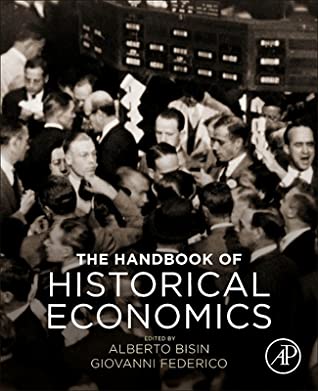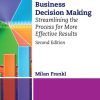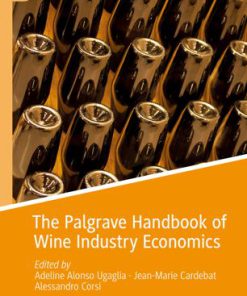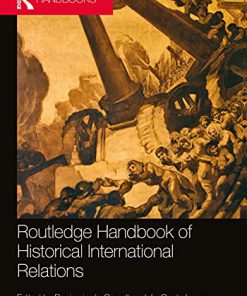The Handbook of Historical Economics 1st edition by Alberto Bisin, Giovanni Federico 9780128162682 0128158743
$50.00 Original price was: $50.00.$25.00Current price is: $25.00.
The Handbook of Historical Economics 1st edition by Alberto Bisin, Giovanni Federico – Ebook PDF Instant Download/Delivery: 9780128162682, 0128158743
Full dowload The Handbook of Historical Economics 1st edition after payment

Product details:
• ISBN 10:0128158743
• ISBN 13:9780128162682
• Author:Alberto Bisin, Giovanni Federico
The Handbook of Historical Economics guides students and researchers through a quantitative economic history that uses fully up-to-date econometric methods. The book’s coverage of statistics applied to the social sciences makes it invaluable to a broad readership. As new sources and applications of data in every economic field are enabling economists to ask and answer new fundamental questions, this book presents an up-to-date reference on the topics at hand.
The Handbook of Historical Economics 1st Table of contents:
1. Historical Economics
2. Sources, methods, models, topics
3. The challenges of Historical Economics
4. Conclusions
References
Part 1: What is historical economics
Chapter 1: The economic history of economic history: the evolution of a field in economics
Abstract
Acknowledgements
1.1. Introduction
1.2. Economics and economic history in the United States before World War Two
1.3. The cliometrics revolution
1.4. Not your father’s economic history
References
Chapter 2: The two revolutions in economic history
Abstract
Acknowledgements
2.1. Introduction
2.2. The Cliometric Revolution
2.3. Intermezzo: economic history at the turn of the 20th century
2.4. The Second Revolution: a general view
2.5. The Second Revolution: beyond the traditional boundaries of economic history
2.6. Conclusions
2.7. Appendix
References
Chapter 3: History as evolution
Abstract
3.1. Introduction
3.2. The benefits of cultural evolution
3.3. Insights from a recognition of history as evolution
3.4. Contributions of economics to cultural evolution
3.5. Conclusions
References
Part 2: Sources and methods
Chapter 4: Historical data: where to find them, how to use them
Abstract
4.1. Introduction
4.2. Geographical data
4.3. Ethnographic data
4.4. Censuses
4.5. Other historical data
4.6. Conclusions
References
Chapter 5: The use of archaeological data in economics
Abstract
5.1. Introduction
5.2. The stone age
5.3. Persistent economic disparities
5.4. The rise of the state
5.5. The emergence of long-distance trade
5.6. Other available databases
5.7. Conclusion
References
Chapter 6: Ethnographic and field data in historical economics
Abstract
6.1. Introduction
6.2. Ethnographic data sources
6.3. Additional data sources
6.4. Lab-in-the-field experiments
6.5. Conclusion
References
Chapter 7: Historical Econometrics: Instrumental Variables and Regression Discontinuity Designs
Abstract
7.1. Introduction
7.2. Identification in economic history
7.3. General trends: 2000-2020
7.4. First generation studies: 2001-2011
7.5. A second wave: 2012-2020
7.6. Technical refinements and regression diagnostics
7.7. Concluding remarks
7.8. Appendix
References
Chapter 8: Historical natural experiments: bridging economics and economic history
Abstract
8.1. Introduction
8.2. How did we get here?
8.3. What have we learned?
8.4. Challenges to the analysis of historical natural experiments
8.5. Concluding thoughts
References
Chapter 9: Persistence – myth and mystery
Abstract
9.1. Conceptual challenges
9.2. Econometric challenges
9.3. Conclusion: vanishing for understanding
References
Chapter 10: LATE for history
Abstract
10.1. Introduction
10.2. Persistence studies
10.3. Persistence studies that analyze relationships between current variables
10.4. Pure persistence studies
10.5. Conclusions
10.6. Appendix LATE for school
References
Chapter 11: Dynamic general equilibrium modeling of long and short-run historical events
Abstract
Acknowledgements
11.1. Introduction
11.2. Growth in the very long run
11.3. Business cycle accounting of the 1889-1929 U.S. economy
11.4. Conclusion
References
Chapter 12: Money, banking, and old-school historical economics
Abstract
12.1. Introduction
12.2. Financial development
12.3. Banking and financial crises
12.4. Different types of causal identification
12.5. Historical macroeconomics and the science of story-telling
12.6. Summary and conclusion
References
Chapter 13: Institutional change and institutional persistence
Abstract
13.1. Introduction
13.2. General framework
13.3. Institutional stasis: power begets power
13.4. Institutional change
13.5. Strategic stability
13.6. Path-dependent change
13.7. Designing persistence
13.8. Social mobility and institutional change
13.9. Culture and institutions
13.10. Conclusion
References
Chapter 14: How institutions and cultures change: an evolutionary perspective
Abstract
14.1. Introduction
14.2. Evolutionary selection: the origin of private property
14.3. Wars and revolutions: a unified model of equilibrium selection
14.4. Within-population transitions
14.5. Evolutionary selection within and between populations
14.6. Darwin, Marx, and the evolutionary selection of institutions
14.7. The demise of serfdom and the rise of the national state
14.8. The 20th-century evolution of collective bargaining in the U.S.
14.9. Conclusion
References
Chapter 15: State power and conflict driven evolution
Abstract
15.1. Introduction and historical contest
15.2. A model
15.3. The fall of Malthus
15.4. The fall of the Qing dynasty
15.5. Peace
15.6. Prosperity
References
Chapter 16: Culture, institutions, and policy
Abstract
16.1. Introduction
16.2. A model of political agency
16.3. Cultural evolution
16.4. Institutional choice
16.5. Cultural evolution and institutional change
16.6. Taking stock
References
Chapter 17: Phase diagrams in historical economics: culture and institutions
Abstract
17.1. Introduction
17.2. Institutional and cultural change
17.3. The interaction of culture and institutions
17.4. Property rights and conflict
17.5. Conclusions
17.6. Appendix Property rights and conflict
References
Part 3: Topics
Chapter 18: The economic history of commodity market development
Abstract
18.1. Introduction
18.2. What happened: the growth of markets over the very long run
18.3. Why it happened: trade costs
18.4. Why it happened: institutions and efficient markets
18.5. On the effects of the development of markets
18.6. Conclusions
References
Chapter 19: Why Africa is not that poor
Abstract
Acknowledgements
19.1. Introduction
19.2. Africa in the spotlight
19.3. Historical causes of African underdevelopment
19.4. Why Africa is not that poor
19.5. Epilogue
References
Chapter 20: Religion in economic history: a survey
Abstract
20.1. Introduction
20.2. Judaism
20.3. Christianity
20.4. Islam
20.5. Cross-country studies
20.6. Conclusion
References
Chapter 21: Persistent failure? International interventions since World War II
Abstract
21.1. Introduction
21.2. Scope, definitions, and data sources
21.3. Summary of findings
21.4. Explaining intervention failure
21.5. Future directions
References
Chapter 22: The ancient origins of the wealth of nations
Abstract
22.1. Introduction
22.2. Evolutionary processes and the transition from stagnation to growth
22.3. The “out of Africa” hypothesis of comparative development
22.4. Concluding remarks
References
Chapter 23: Social mobility in historical economics
Abstract
23.1. Introduction
23.2. Conventional measures of social mobility
23.3. Measuring social mobility rates from surnames
23.4. Estimating long run mobility rates from surnames, Australia 1903-1980
23.5. Estimating social mobility rates from surnames with less information
23.6. Are there immobile societies?
23.7. Conclusion
References
Chapter 24: The Industrial Revolution and the Great Divergence: recent findings from historical national accounting
Abstract
24.1. Introduction
24.2. Data and methods
24.3. The Industrial Revolution
24.4. The Great Divergence
24.5. Conclusions
References
Chapter 25: Attitudes, aptitudes, and the roots of the great enrichment
Abstract
25.1. Introduction
25.2. Europe and the world
25.3. Attitudes
25.4. Aptitudes
25.5. Apprenticeship and human capital
25.6. Conclusion
References
Chapter 26: The interplay among wages, technology, and globalization: the labor market and inequality, 1620-2020
Abstract
26.1. The framework of analysis
26.2. Phase 1: pre-industrial economic growth: 1620-1770
26.3. Phase 2: Industrial Revolution, 1770-1867: wages affected technology
26.4. Phase 2: Industrial Revolution: technology affected wages
26.5. Phase 3: the age of manufactures, 1867-1973: wages affected technology
26.6. Phase 3: the age of manufactures, 1867-1973: technology and globalization influenced wages
26.7. Phase 4: the shift to services, 1973-present: wages affect technology
26.8. Phase 4: the shift to services, 1973-present: technology affects the labor market
26.9. Conclusion
References
Chapter 27: Debt and taxes in eight U.S. wars and two insurrections
Abstract
27.1. Introduction
27.2. Two theories of war finance
27.3. Government budget constraint
27.4. Expenditures and tax revenue
27.5. Returns to bondholders
27.6. Debt design, marketing, and management
27.7. Insurrections
27.8. Qualifications
27.9. Appendix A Accounting
27.10. Appendix B Data sources
References
Chapter 28: Biogeography, writing, and the origins of the state
Abstract
28.1. Biogeography and state origins
28.2. Technology and state origins
28.3. The origins of writing
28.4. Data and empirical strategy
28.5. First stage estimates
28.6. Second stage estimates
28.7. Writing and specific state characteristics
28.8. Conclusion
References
Chapter 29: The wife’s protector: a quantitative theory linking contraceptive technology with the decline in marriage
Abstract
29.1. Introduction
29.2. The decline in marriage
29.3. Contraception in the 19th and 20th centuries
29.4. Setup
29.5. Married or single life?
29.6. An abstinent or sexual non-marital relationship?
29.7. Statistical mechanics
29.8. Calibration
29.9. Conclusions
29.10. Literature review
29.11. Appendix A Beers’s specification of letters patent
29.12. Appendix B Theory
29.13. Appendix C Data sources
References
Index
People also search for The Handbook of Historical Economics 1st:
the handbook of historical economics
the handbook of historical linguistics
handbook of historical economics
handbook of the economics of art and culture
handbook of the economics of finance
You may also like…
Politics & Philosophy - Anthropology
Historical Dictionary of Spanish Cinema 2nd Edition by Alberto Mira ISBN 9781538122686 1538122685
Politics & Philosophy
The Ethics of Vaccination 1st Edition by Alberto Giubilini ISBN 9783030020675 3030020673
History & Research
Medicine
The Forensic Examination: A Handbook for the Mental Health Professional Alberto M. Goldwaser
Business & Economics
Business & Economics
The Palgrave Handbook of Economics and Language 1st Edition Victor Ginsburgh
Politics & Philosophy - International Relations
Routledge Handbook of Historical International Relations 1st Edition Benjamin De Carvalho
Business & Economics - Economics












